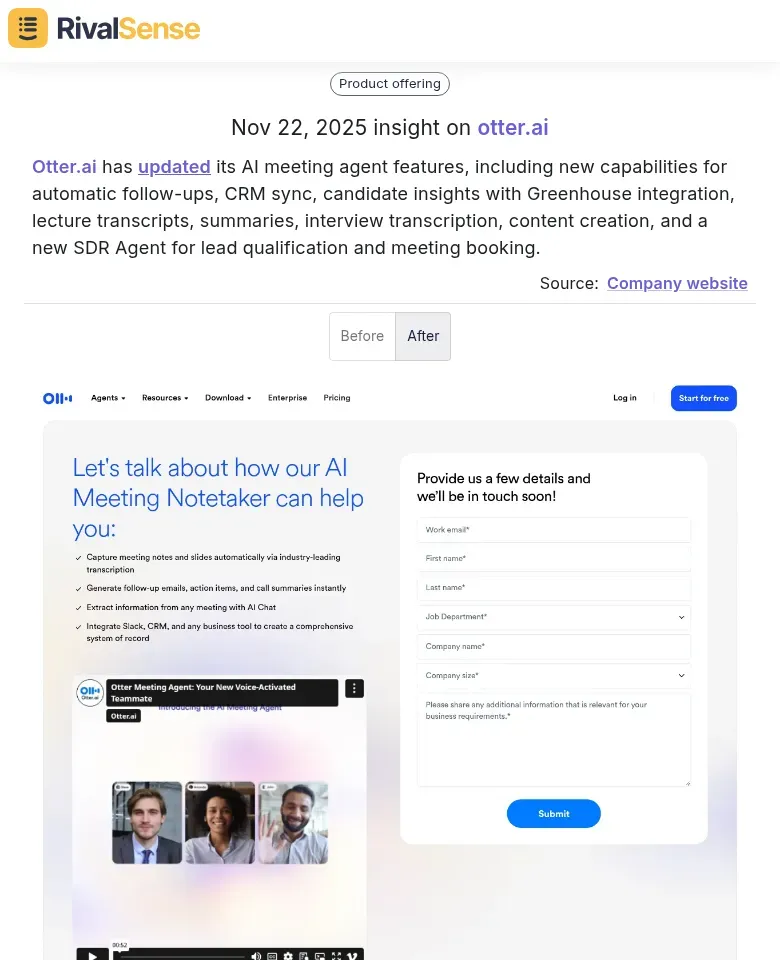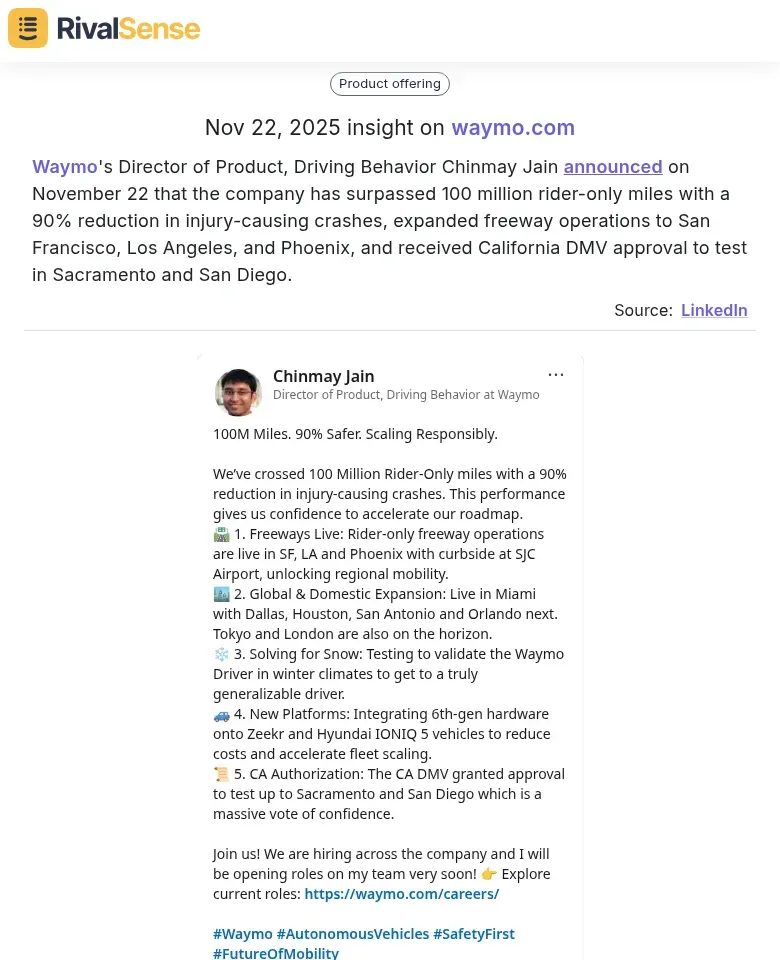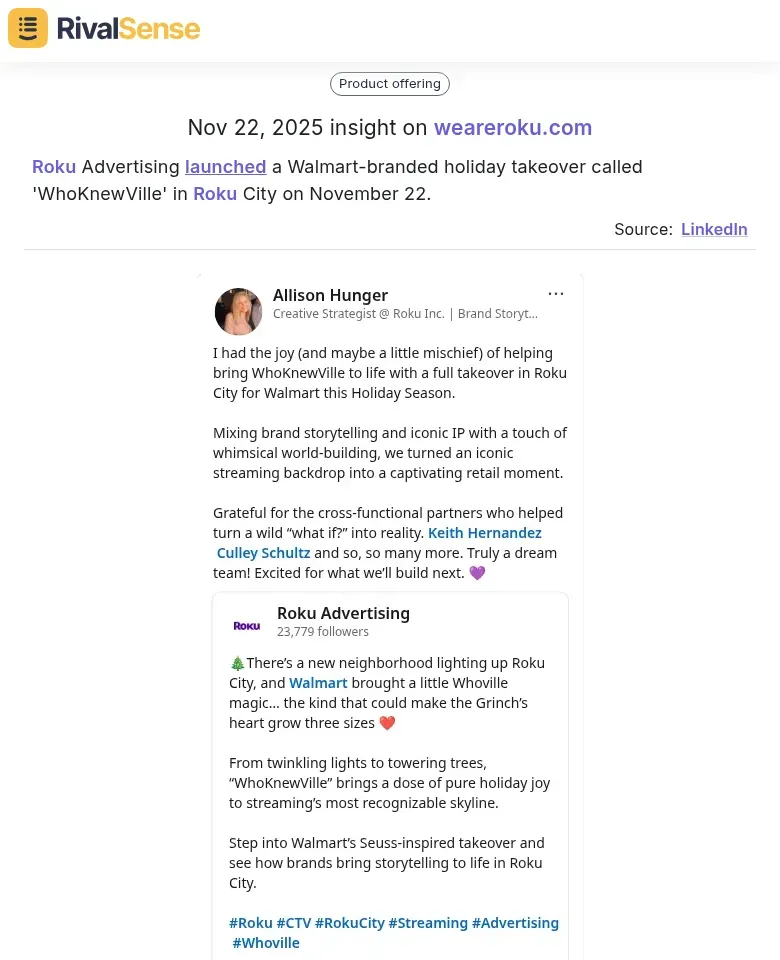Product Offering Competitor Analysis: Template & Framework
Product offering competitor analysis is the systematic process of evaluating competitors' products, features, pricing, and updates to inform strategic decisions. It's crucial for identifying market gaps, avoiding feature parity, and uncovering innovation opportunities. By understanding what rivals offer, you can position your product uniquely and allocate resources effectively.
Tracking competitor product updates drives market positioning and innovation. When you monitor feature releases, pricing changes, or new integrations, you gain insights into market trends and customer demands. This enables you to anticipate shifts, differentiate your offerings, and prioritize development that resonates with users. For example, if a competitor adds AI-powered analytics, you might explore enhancing your own analytics or focusing on underserved areas.
Real-time insights are vital for adapting to competitive landscapes. Markets evolve rapidly, and delayed information can lead to missed opportunities or reactive strategies. Use tools like RivalSense to set up alerts for competitor announcements, product launches, and customer feedback.
Practical Steps to Get Started:
- 🔍 Identify key competitors and their core products
- 📈 Monitor their websites, blogs, and social media for updates
- 💬 Analyze customer reviews to spot strengths and weaknesses
- 🔄 Regularly review your findings to adjust your roadmap
This proactive approach ensures you stay agile and responsive in a dynamic environment.
Framework for Analyzing Competitor Product Features
To effectively analyze competitor product features, a structured framework is essential. This approach helps in systematically evaluating strengths, weaknesses, and opportunities, enabling data-driven decisions for your product roadmap. By breaking down features into manageable components, you can identify gaps and prioritize improvements that align with market demands.
For instance, tracking product updates like Otter.ai's recent enhancements to its AI meeting agent features—including automatic follow-ups, CRM sync, and new integrations—can reveal trends in automation and customer engagement. This type of insight is valuable for refining your own feature set and staying ahead in competitive landscapes.

Follow this systematic framework to analyze competitor product features and identify strategic opportunities:
-
Feature Inventory: Create a comprehensive spreadsheet listing all competitor features, categorizing them by core functionality, integrations, and unique capabilities. Track feature release dates and update frequency.
-
Capability Scoring: Rate each feature on a 1-5 scale for user experience, technical sophistication, and market demand. Compare scores against your own product to identify gaps.
-
Integration Mapping: Document all third-party integrations and partnerships. Note which integrations drive the most customer value and market differentiation.
-
Opportunity Analysis: Identify feature gaps where competitors excel but your product lacks. Prioritize based on customer pain points and market demand signals.
Practical Tips for Implementation:
- 📊 Use feature comparison matrices to visualize competitive positioning
- 🔔 Monitor competitor release notes and changelogs weekly
- 🤝 Track integration announcements through partnership press releases
- 🗓️ Conduct quarterly gap analysis sessions with product and sales teams
Focus on monitoring integration ecosystems closely—partnerships often create competitive moats that are harder to replicate than individual features. The most successful companies don't just match features; they build superior integration networks that lock in customer value.
Learning from Competitor Innovation and Expansion
Competitors often innovate and expand in ways that can inform your own strategy. By learning from their moves, you can anticipate market trends, avoid pitfalls, and capitalize on emerging opportunities. This section explores how to leverage competitor announcements for strategic advantage, from building trust through data milestones to scaling operations effectively.
Analyzing how competitors use data like safety milestones to build trust and market credibility is key. For example, if a competitor announces achieving significant safety records, they're signaling reliability. Track such announcements and assess their impact on customer perception and media coverage. Use this insight to set and publicize your own milestones, enhancing your brand's trustworthiness.
Waymo's Director of Product recently highlighted surpassing 100 million rider-only miles with a 90% reduction in injury-causing crashes, along with geographic expansions. Monitoring such expansions and safety achievements is valuable for benchmarking your growth strategies and building credibility in regulated or high-stakes industries.

Explore strategies for scaling operations and entering new markets based on competitor successes. Observe how competitors expand geographically or into new segments—perhaps through partnerships or localized marketing.
Checklist for Market Expansion:
- 🎯 Identify target markets and analyze competitor entry tactics
- ⚠️ Assess risks and plan phased rollouts
- 🤝 Consider alliances or joint ventures to reduce barriers
- 📈 Monitor competitor performance in new regions
Identify how public announcements of achievements inform your growth and PR tactics. Competitors often use press releases for milestones like revenue targets or product launches. Monitor these to refine your PR strategy.
Tips for Effective PR:
- ⏰ Issue timely announcements aligned with market cycles
- 📊 Highlight data-driven results to bolster credibility
- 📰 Leverage media relationships for wider coverage
- 🔄 Emulate successful competitor tactics but add unique angles
Practical steps include using tools like Google Alerts for tracking, developing a milestone calendar, and integrating competitor insights into scaling plans.
Competitive Campaigns and Marketing Insights
Competitive campaigns reveal strategic opportunities beyond product features, offering insights into engagement tactics and brand positioning. By analyzing how competitors execute marketing initiatives, you can uncover patterns that drive visibility and customer acquisition, helping you refine your own campaigns for maximum impact.
For example, Roku Advertising's 'WhoKnewVille' holiday takeover in Roku City demonstrates how seasonal, platform-specific campaigns can capture attention during key planning periods. Tracking such campaigns is valuable for understanding engagement spikes and optimizing your marketing spend around high-impact events.

Analyze how competitors execute branded takeovers and seasonal campaigns—these drive engagement spikes and visibility. For instance, a holiday-themed takeover on industry platforms can capture attention when decision-makers are planning budgets. Track campaign timing, messaging themes, and engagement metrics (e.g., click-through rates) to identify patterns.
Creative partnerships, like collaborations with retailers or influencers, differentiate brands in crowded markets. Assess competitors' partnerships for mutual benefits: expanded reach, credibility boosts, or access to new customer segments. Look for co-branded content, exclusive offers, or joint events that resonate with shared audiences.
Leverage platform-specific features for targeted advertising. Competitors using advanced ad tools likely achieve higher conversion rates. Monitor their ad formats (e.g., carousel ads, video content) and audience segmentation strategies.
Quarterly Campaign Audit Checklist:
- 📅 Note platforms used and campaign timing
- 🤝 Document partnership details and co-branding efforts
- 📊 Track performance indicators like engagement rates
- 🧪 Test small-scale takeovers in off-peak seasons to gauge impact
Tips: Emulate successful elements but innovate to stand out, and use A/B testing to optimize your approaches.
Template for Implementing Competitor Analysis
Implementing a competitor analysis requires a practical template to ensure consistency and thoroughness in tracking changes. This structured approach helps teams collaborate effectively, turning raw data into actionable strategies that keep your product ahead of the curve. By regularly updating and refining this template, you can maintain a proactive stance in a fast-moving market.
Use this customizable template to systematically track competitor product changes and launches. Structure it with these key sections:
Feature Comparison Matrix: Document competitor features, pricing tiers, and target segments. Include columns for your product vs. each competitor, noting gaps and strengths. Example: If a rival launches AI-powered analytics, log it with your current capabilities.
Market Response Analysis: Track user reviews, social media sentiment, and press coverage post-launch. Use tools like review aggregators to gauge adoption rates and pain points.
Strategic Recommendations: Based on gaps, prioritize actions—e.g., accelerate development for missing features or highlight your unique selling points in marketing.
Tips for Effective Implementation:
- 🗓️ Update weekly with calendar reminders to review competitor sources
- 🔄 Integrate findings into product sprints and development meetings
- 👥 Use shared digital tools (e.g., spreadsheets or project software) for team collaboration
- 📋 Conduct monthly reviews to adjust strategies based on new insights
This framework ensures continuous monitoring, helping you stay agile and informed in a dynamic market.
Conclusion: Turning Insights into Action
Competitor analysis isn't a one-time task—it's a strategic discipline that fuels product innovation and market leadership. By systematically analyzing competitors' offerings, you gain actionable insights to refine your product roadmap, prioritize features that deliver unique value, and avoid costly missteps. Key takeaways include identifying gaps in the market, benchmarking against industry standards, and anticipating shifts in customer expectations.
To turn insights into action, adopt a proactive monitoring approach: set up regular competitor tracking (e.g., quarterly reviews), use tools to automate alerts on product launches or pricing changes, and integrate findings into your product planning cycles. Practical steps include creating a 'competitor insights' dashboard, conducting SWOT analyses, and holding cross-functional workshops to align teams.
Remember, continuous learning from competitors—whether through their successes or failures—builds resilience and drives long-term growth. Stay agile, iterate based on data, and leverage these practices to not just compete, but lead in dynamic markets.
To assist with the challenges described in this post, try out RivalSense for free at https://rivalsense.co/ and get your first competitor report today to stay ahead of the competition.
📚 Read more
👉 Leveraging Competitor Executive Changes for Strategic Insights
👉 The Ultimate Guide to Key Account Management Assessment: Driving Growth Through Strategic Evaluation
👉 Case Study: Competitor Backlink Tracking Drives Strategic Vision
👉 How VEED's Nano Banana Pro Uncovered Competitors' AI Edge
👉 Best Practices: Instagram Competitor Insights for Tracking Key Decision Makers
